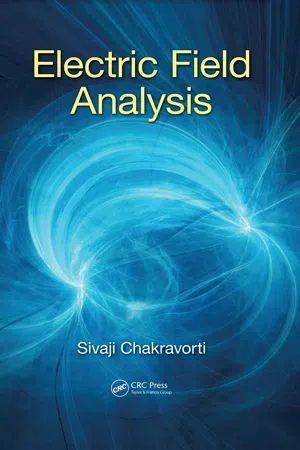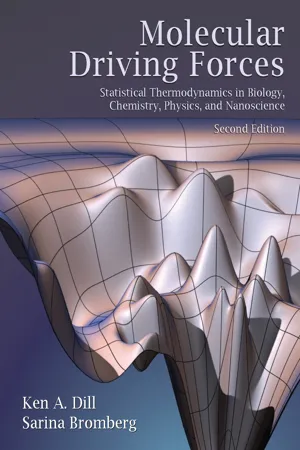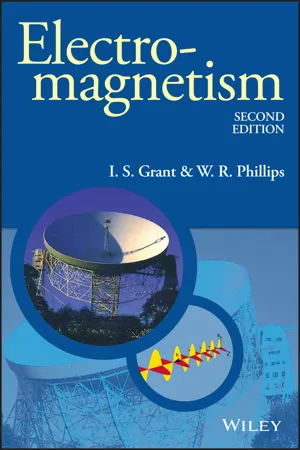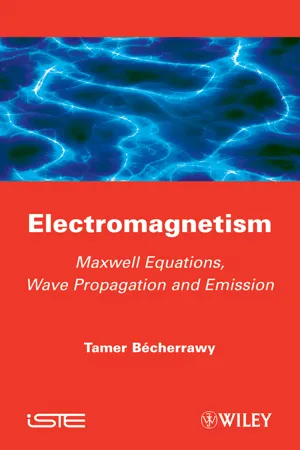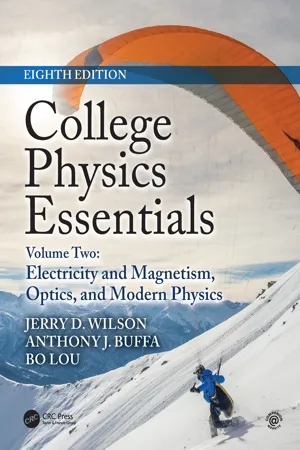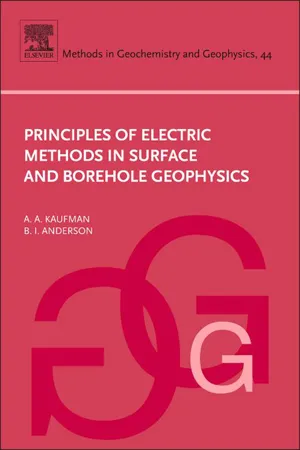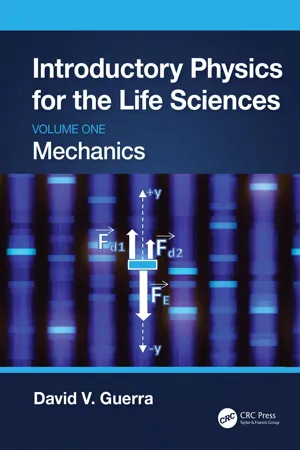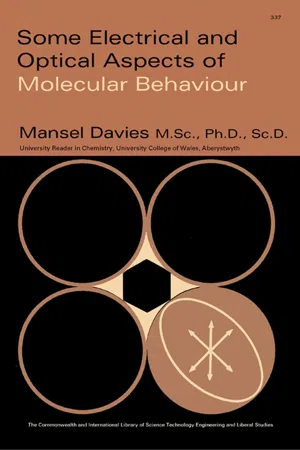Chemistry
Coulomb Force
Coulomb force is the attraction or repulsion between two charged particles. It is directly proportional to the product of the charges and inversely proportional to the square of the distance between them. This force plays a crucial role in the interactions between atoms and molecules in chemical reactions.
Written by Perlego with AI-assistance
Related key terms
Related key terms
1 of 4
Related key terms
1 of 3
12 Key excerpts on "Coulomb Force"
- eBook - ePub
- Sivaji Chakravorti(Author)
- 2017(Publication Date)
- CRC Press(Publisher)
It is the law that describes the electrostatic interaction between electrically charged particles. It was published by the French physicist Charles Augustin de Coulomb in 1785. He determined the magnitude of the electric force between two point charges using a torsion balance to study the attraction and repulsion forces of charged particles. The interaction between charged particles is a non-contact force that acts over some distance of separation. There are always two charges and a separation distance between them as the three critical variables that influence the strength of the electrostatic interaction. The unit of the electrostatic force, like all forces, is Newton. Being a force, the strength of the electrostatic interaction is a vector quantity that has both magnitude and direction.According to the statement of Coulomb’s law (1) the magnitude of the electrostatic force of interaction between two point charges is directly proportional to the scalar multiplication of the magnitudes of point charges and inversely proportional to the square of the separation distance between the point charges and (2) the electrostatic force of interaction acts along the straight line joining the two point charges. If the two point charges are of same polarity, the electrostatic force between them is repulsive; if they are of opposite polarity, the force between them is attractive.FIGURE 1.3 Electrostatic forces of interaction between two point charges.It should be noted here that two conditions are to be fulfilled for the validity of Coulomb’s law: (1) the charges involved must be point charges and (2) the charges should be stationary with respect to each other.Mathematically, the force between two point charges, as shown in Figure 1.3 , could be written as follows:where:=F →2 1±Q 2⋅Q 14 πε 0|r →2 1| 2andu ˆr 2 1=F →1 2Q 1⋅ ±Q 24 πε 0|r →1 2| 2sothatu ˆr 1 2= -F →2 1F →1 2 ( 1.1 )- ε0 is permittivity of free space (≈8.854187 × 10–12
- eBook - ePub
Molecular Driving Forces
Statistical Thermodynamics in Biology, Chemistry, Physics, and Nanoscience
- Ken Dill, Sarina Bromberg(Authors)
- 2010(Publication Date)
- Garland Science(Publisher)
20 Coulomb’s Law of Electrostatic Forces Charge Interactions Are Described by Coulomb’s LawElectrical interactions between charges govern much of physics, chemistry, and biology. They are the basis for chemical bonding, weak and strong. Salts dissolve in water to form the solutions of charged ions that cover three-quarters of the Earth’s surface. Salt water forms the working fluid of living cells. pH and salts regulate the associations of proteins, DNA, cells, and colloids, and the conformations of biopolymers. Nervous systems would not function without ion fluxes. Electrostatic interactions are also important in batteries, corrosion, and electroplating.Charge interactions obey Coulomb’s law. When more than two charged particles interact, the energies are sums of Coulombic interactions. To calculate such sums, we introduce the concepts of the electric field, Gauss’s law, and the electrostatic potential. With these tools, you can determine the electrostatic force exerted by one charged object on another, as when an ion interacts with a protein, DNA molecule, or membrane, or when a charged polymer changes conformation.Coulomb’s law was discovered in careful experiments by H Cavendish (1731–1810), J Priestley (1733–1804), and CA Coulomb (1736–1806) on macroscopic objects such as magnets, glass rods, charged spheres, and silk cloths. Coulomb’s law applies to a wide range of size scales, including atoms, molecules, and biological cells. It states that the interaction energy u(r) between two charges in a vacuum isu( r )=,Crq 1q 2(20.1) where q1 and q2 are the magnitudes of the two charges, r is the distance separating them, andC = 1 / 4 πis a proportionality constant (see box below).ε 0UnitsThe proportionality constant C in Equation (20.1) depends on the units used to measure the charge and the distance. In the older c.g.s. system, the units were defined so thatC = 1. We use the SI system, in which the unit of charge is the coulomb C, the unit of energy is the joule J, and the unit of distance is the meter m. The corresponding constant C equals (4πε0 )−1 . The factor ε0 is called the permittivity of the vacuum. In SI units, ε0 = 8.85 × 10−12 Fm−1 . The farad F is the SI unit of capacitance, equal to 1 C V−1 . The volt V is the SI unit of electrical potential, which is equal to 1 JC−1 . So ε0 = 8.85 × 10−12 C2 J−1 m−1 . In c.g.s. units, the unit of charge is 1 statcoulomb or 1 esu = 3.00 × 109 C, the unit of potential is 1 statvolt = (1/300) V, and the unit of capacitance is 1 statfarad = 9 × 1011 - eBook - ePub
- I. S. Grant, W. R. Phillips(Authors)
- 2013(Publication Date)
- Wiley(Publisher)
1 isIn general, the force Fj on a chargeqjdue to a number of other chargesqiisThe symbol i ≠ j under the summation signs indicates that the summation for charge i is over all the other charges j , but of course not including charge i itself. This equation can be written in another way in terms of the position vectors of the charges with respect to a fixed origin O. If the position vectors of the charges q 1 , q 2 … q i … are r1 , r2 … ri … then the vector joining charges i and j is rij = rj – ri . The total force onqjis thus(1.3)A trivial example of the application of Equation (1.3) is in working out the electrostatic forces exerted by atomic nuclei containing many protons on the electrons surrounding them. Nuclei are much smaller than atoms, and for this purpose can be regarded as point charges. Equation (1.3) then tells us that the attractive force between an electron and a nucleus containing Z protons is Z times as great as that between an electron and a single proton.It turns out that apart from the sign, the charge carried by electrons and protons is the same, and has the magnitude e = 1.602 × 10−19 coulombs* : the charge on the proton is +e , that on the electron is – e . The strength of atomic interactions is governed by the size of the electronic charge e . Although e - eBook - ePub
- A. L. Stanford, J. M. Tanner(Authors)
- 2014(Publication Date)
- Academic Press(Publisher)
11Electric Charge and Electric Fields
Publisher Summary
This chapter begins our study of electric and magnetic phenomena, collectively called electromagnetism . Electromagnetic forces, like gravitational forces, are fundamental interactions that occur between particles. Just as mass is that property of matter that engenders gravitational attraction, electric charge is a property of certain fundamental particles, like electrons and protons, that causes electromagnetic interaction. Our investigation of electrostatics , the analysis of interactions between charges at rest, is based on a force law for charges and on the concept of electric fields. The force law for charges, called Coulomb’s law, is the electrical analogue of the law of universal gravitation. The electric field is an abstract concept used to characterize how the presence of charge alters the properties of the space around that charge.11.1 Electric Charge and Coulomb’s Law
Electric charges exist in two forms, called positive charge and negative charge . The natural unit of charge is the positive charge of a proton or the negative charge of an electron. The SI unit of charge is the coulomb (C), which will be defined later in terms of electric current. This unusual definition is used because of the difficulty of making reproducible measurements on quantities of charge. For now, we will use as a measure of charge the experimentally obtained value for e , the magnitude of the charge of an electron or proton:e = 1.60 ×(11-1)10C− 19(11-1)Equivalently, a coulomb is the quantity of charge carried by 6.25 × 1018 electrons.An electron (or proton) bears the smallest unit of charge found in nature, so any quantity of charge q occurs as an integral number n of the basic charge e , or q = ne . Thus, as with any physical quantity made up of a number of “minimum parcels,” we say that electric charge is quantized; the least quantity that occurs, the quantum of charge, is the electronic charge e - eBook - ePub
- Lubos Brieda(Author)
- 2019(Publication Date)
- CRC Press(Publisher)
Coulomb Force,=F →c , i j14 πϵ 0q iq j|3|−x →ix →j()−x →ix →j(1.2) where the i and j are indexes of two unique particles with charges qi and qj . ϵ0 ≈ 8.8542 × 10−12 C/(Vm) is a physical constant known as permittivity of free space. This formulation ignores magnetic field effects found with moving charges. The total force acting on a single particle i is
where the sum is over all particles in the system. Particle velocity can also change through collisions. We thus have=F →c , ii ≠ j∑ j NF →c , i j(1.3) =dv →d t1 m(+)+F →g+ …F →c()dv →d tc o l(1.4) Although gravity is included in the above formulation, it is customary to ignore it. A quick “back of the envelope” calculation demonstrates why. Large vacuum chambers used in plasma processing operate at pressures p around 10−6 Torr (1 Torr is 1/760th of 1 atmosphere). Using the ideal gas law, p = nkB T, where kB ≈ 1.381 × 10−23 J/K is the Boltzmann constant and T is the room temperature, the average number density n is around 3.3 × 1016 particles per cubic meter. The mean inter-particle spacing can be estimated from the volume needed to be assigned to each ion to fill a unit cube. Modeling each particle as a cube with sides a, the particles are a = (1 / n)1/3 or approximately 3 μm apart. At this distance, the Coulomb Force is around 10−17 N. Even for the heavy xenon used in plasma propulsion, the force of gravity, F = mg, is only 10−24 N. The gravitational force is thus seven orders of magnitude smaller than the electrostatic Coulomb Force. In the Low Earth Orbit (LEO), the ambient plasma density drops to 1012 m−3 - eBook - ePub
Electromagnetism
Maxwell Equations, Wave Propagation and Emission
- Tamer Becherrawy(Author)
- 2013(Publication Date)
- Wiley-ISTE(Publisher)
Chapter 2Electrostatics in Vacuum
The interaction of electric charges, as expressed by Coulomb Force, is formulated according to the Newtonian concept of action-at-a-distance: if a charge q′ is produced at r′ at a time t′, a charge q located at r feels the action of q′ instantaneously, whatever the distance |r − r′| and the medium that separates the charges. The concept of field was developed by Faraday, Maxwell, Lorentz, Einstein, and many others. In modern physics, all interactions are conceived as local, i.e. involving quantities defined at the same point r and at the same time t. Fields are physical entities that are endowed with energy, momentum, etc., and they may propagate with some finite speed as waves. Furthermore, in quantum theory, the same objects (electrons for instance) have both particle and wave properties.In this chapter, we introduce the concepts of electric field and potential, we derive the fundamental equations of electrostatics in vacuum, and we discuss some of their properties and the concept of electrostatic energy.2.1. Electric forces and fieldIn a famous experiment, Coulomb used a torsion balance to measure the force of interaction of electric charges. He verified that a small charge q1 acts on a small charge q2 situated at a distance r with a force FE = Ko q1 q2 /r2 oriented along the line joining the charges. This force is repulsive between like charges and attractive between unlike charges. It has a similar mathematical form to Newton's law of universal gravitation To specify both the direction and the magnitude, we write[2.1 ]Coulomb's force obeys the principle of action and reaction. Ko is a constant that depends on the adopted unit of charge. Using the coulomb (C) as the unit of charge and the Heaviside or rationalized system, we write[2.2]εo is the permittivity of vacuum. The factor 4π is introduced to simplify the writing of equations. The electric force is much more intense than the gravitational force and the coulomb is an enormous charge on the human scale: electric sparks are produced by less than one microcoulomb and rubbing produces a charge of the order of the nanocoulomb per square centimeter - eBook - ePub
College Physics Essentials, Eighth Edition
Electricity and Magnetism, Optics, Modern Physics (Volume Two)
- Jerry D. Wilson, Anthony J. Buffa, Bo Lou(Authors)
- 2019(Publication Date)
- CRC Press(Publisher)
2 ), see Section 7.5.Coulomb’s measurements provided an experimental value for a constant of proportionality, k , so the electric force could be written as an equation known as Coulomb’s law :F e=kq 1q 2r 2(point charges only, q meansmagnitude)(15.2) where k = 8.988 × 109 N· m2 /C2 ≈ 9.00 × 109 N· m2 /C2 .Equation 15.2 gives the force between any two charged particles as shown in ▲ Figure 15.7a . In general, for several charges, the mathematics involves vector addition, as shown in Figure 15.7b . The following Example provides some insight into the qualitative use of Coulomb’s law.Conceptual Example 15.2: Free of Charge – Electric Forces▲ Figure 15.7 Coulomb’s law (a) The mutual electrostatic forces between two point charges are equal and opposite. (b) For a configuration of two- or more point charges, the force on a particular charge is the vector sum of the forces on it due to all the other charges. (Note : In each of these situations, all of the charges are of the same sign. How can we tell that this is true? Can you tell their sign? What is the direction of the force on q 2 due to q 3 ?)A rubber comb combed through dry hair can acquire a net negative charge. That comb will then attract small pieces of uncharged - Alex Kaufman, B. Anderson(Authors)
- 2010(Publication Date)
- Elsevier Science(Publisher)
This chapter introduces the theory of stationary electric fields—that is, the theory of electric fields that do not vary with time—starting from Coulomb’s law of force between electric charges and the principle of superposition. The concepts of electric field and electric potential are then developed, along with the general equations that these fields satisfy and their solutions in simple configurations. The material developed here will be used repeatedly in subsequent chapters to study the applications of stationary electric fields in surface and borehole methods of geophysics.1.1 INTERACTION OF ELECTRIC CHARGES AND COULOMB’S LAW
The force of interaction between electric charges is, like the force of gravity, one of the fundamental concepts of physics. The French physicist Charles-Augustin de Coulomb (1736–1806) was the first to study quantitatively this remarkable phenomenon in experiments carried out at the end of eighteenth century. In this chapter, we consider these concepts only at the “macroscopic” level, which means that the dimensions of regions where “elementary” charges are located are assumed to be much smaller than the distances between these regions, while elementary charges themselves can have an arbitrary value. Coulomb’s law then states that the force acting on an elementary charge located at the point p , caused by a second elementary charge located at the point q , is given by the simple expression:F ( p ) =14 πε 0d e ( q ) d e ( p )L qp 3L qp.[1.1]Here de (p ) and de (q ) are the numerical values of the elementary charges, L qp is the vector directed from the point q to the point p , L qp is the distance between these points, and ε 0 is a constant of nature. In the standard International System of units (S.I. units), force is measured in “newtons” (N), which according to Newton’s Second Law has dimensions of mass times acceleration, or kilogram–meter per second squared (kg m s− 2 ); charge is measured in “coulombs” (C); and distance is measured in meters. The constant ε 0 then has the valueε 0=136 π10F− 9m,− 1where “F” is a unit called the “farad.” Its dimensions can be worked out from Eq. [1.1] , but will later be expressed more simply after some further electrical units are introduced. Noting that the vector separation L qp- Nima Gharib, Javad Farrokhi Derakhshandeh, Peter Radziszewski(Authors)
- 2022(Publication Date)
- Elsevier(Publisher)
Coulomb's law and electric field 3.1. Coulomb's law The basic electromagnetic concepts are studied one by one in sequence. A dimensional description will suffice in the vast majority of cases; the latter will be deduced from their relationship via the theory's basic equations, which will be tested experimentally. The next section will take place immediately after the current enumeration of essential concepts. To understand how much force does a single point charge q exert on a test charge Q while it is at rest r distance away, Coulomb's law can evaluate the answer as follows: (3.1) The constant ε 0 = (8.85 × 10 − 12 C 2 /N m 2) is referred to as open space permittivity (ludicrously). In SI units, newton (N) denotes force, meter (m) denotes distance, and coulomb denotes charge (C). In other words, the force is proportional to the charge product and inversely proportional to the square of the separation distance. Here, item Δ r is the separation vector with magnitude of r. The force is directed down the line q-Q ; it is repulsive if q and Q have the same sign, and attractive if they have the opposite sign. Coulomb's law and the principle of superposition provide the physical basis for electrostatics; all else is mathematical development of these basic laws, with the exception of a few specific features and elaboration these rules. 3.2. The electric field If there are many point charges, such as q 1, q 2, …, q n at distances r 1, r 2, …, r n from Q, the total force on Q is then equal to (3.2) or (3.3) Here, (3.4) Factor E (r) is referred to as the source of electric field charge, which is a function of position (r), since the separation vectors r i are location-dependent. However, it makes no mention of the test charge Q. The electric field is a vector quantity that varies across points and is governed by the arrangement of source charges as shown in Fig. 3.1 ; physically, E (r) is the force per unit charge that would be exerted on a test charge if placed at P. 4- eBook - ePub
- Sir Alan Cottrell(Author)
- 2019(Publication Date)
- CRC Press(Publisher)
Chapter 4Chemical Bonding
4.1 Forces between atoms
The physical meaning of chemical affinity is that an attractive force exists between the atoms. There is also a repulsive force at close range which is the basis of the ‘impenetrability’ of matter. The equilibrium spacing of a pair of atoms is that at which these two forces are equal. Because force is rate of change of energy with distance, the energy of interaction of the pair reaches its lowest value at the equilibrium spacing. Quantum mechanics deals directly with energy, not force, and so it is usual to discuss problems of chemical bonding in terms of energy.We bring two atoms together from infinity, having defined their potential energy of interaction as zero at infinity. Little happens and the energy stays near zero until the atoms are within about an atomic spacing of each other. As they move still closer, the attractive force begins to be felt and the potential energy falls, since work is being done by the atoms as they move together under this force. When they get really close, the short-range repulsive force then also comes into play and soon dominates the attractive force. The potential energy rises at this stage since the atoms are now being pushed together. This behaviour is shown in Fig. 4.1 which gives the potential energy due to the attractive (curve a), repulsive (curve b) and total (curve c) forces as a function of the distance between nuclei. The potential energy ‘well’ is deepest at the equilibrium spacing r and its depth D there is equal to the work required to dissociate the atoms completely.Whether a collection of such atoms will form a gas or condense together into a liquid or solid depends both on D (in relation to the temperature and pressure) and on the nature of the forces. Molecular gases can form even when D is large (e.g. H2 , O2 , N2 , CO2 , at room temperature) if the atomic forces show saturation - David V. Guerra(Author)
- 2023(Publication Date)
- CRC Press(Publisher)
12 .The direction of the force is determined by the types of charges interacting. It is always directed along the line passing through both particles or, when dealing with objects, through their centers. In Figure 5.2 , the objects have charge of the same sign so the forces are repulsive.FIGURE 5.2 Forces on like charges.=q 1|q 1|q 2|q 2|In Figure 5.3 , the objects have charges of opposite signs so the forces are attractive.FIGURE 5.3 Forces on unlike charges.= −q 1|q 1|q 2|q 2|To find the Coulomb Force vector, calculate the magnitude of the force fromand determine the direction of the force using the vector diagram and the fact that unlike charges attract and like charges repel.F 12=k|⋅q 1||q 2|r 25.3.1 Examples of Calculations Using Coulomb’s Law
Example 5.1Find the Coulomb Force on a proton, q1 , located at the origin, due to another proton, q2 , that is 1 × 10−15 m to the right of q1 . These dimensions are similar to the size of the nucleus of an atom, so the solution to this example gives a sense of the strength of the forces pushing the protons apart in the nucleus of atoms larger than hydrogen.- Step 1: As shown in Figure 5.4 , sketch the diagram and label the Coulomb Force F12 on q1 due to q2 .
FIGURE 5.4 Diagram for Coulomb’s Law Example 5.1 .Because both charges are positive, the Coulomb Force on q1 due to q2 is repulsive and points to the left. The subscript used for this force in this diagram is F12 since this is the force on charge 1 due to charge 2. This is a technique used throughout this chapter to label the forces on a charge due to another charge.
- Step 2: Compute the magnitude of the Coulomb Force on charge 1 due to charge 2 using Coulomb’s Law. Remember the charge on a proton is a positive value of q = 1.602 × 10−19 C.
Start with Coulomb’s Law:F 12=k|⋅q 1||q 2|r 2Plug in the values of k, charge, and r
- eBook - ePub
Some Electrical and Optical Aspects of Molecular Behaviour
The Commonwealth and International Library: Chemistry Division
- Mansel Davies, Robert Robinson, H. M. N. H. Irving, L. A. K. Staveley(Authors)
- 2014(Publication Date)
- Pergamon(Publisher)
* But it is clear that the simpler electrostatic features predominate in many systems and that on their basis one obtains an approximate assessment of the interactions occurring. As it is the energy factor which determines the functional importance of most interactions, it is frequently necessary to see what contributions arise from electrostatic factors before invoking other possibilities.Using electrostatic (c.g.s.) units we can write down the expressions for the forces F (in dyne) or the energies U (in erg molecule−1 ) for various particle interactions. As we have already seen (p. 11 ), -ΔU = F . Δr , where -ΔU is the decrease in energy when a particle moves a distance Δr under force F. This gives the general expression, F = -(dU/ dr) and we can conveniently restrict ourselves to the expressions for U.Ion-Ion
Two ions behaving as rigid electric chargeszA eandzB e,where z is the number of electronic charges e involved, have energy:where r is their separation and the z ’s take account of their sign (+ or -) and ε′ is the permittivity of any medium between them. The energy is positive for the like charges and increases as r decreases. The instability expressed by the increasing energy is reflected by the repulsion or negative F values: conditions which are reversed for unlike charges.Ion-Dipole
A dipole μ at angle θ to a field E (Fig. 11 ) has energy μμE cos θ. If an ion, charge ze, is at distance r from the centre of the dipole the field is . In this caseTwo Rigid Dipoles
With the orientation and dimensions shown in Fig. 60 , and with rlA≈lB= l , so that etc.FIG. 60If one of the dipoles rotates through 180° with respect to the other, the above sign is reversed and U (r ) then expresses the net repulsion. Lateral alignment with dipole centres still at distance r (Fig. 60(b)
Index pages curate the most relevant extracts from our library of academic textbooks. They’ve been created using an in-house natural language model (NLM), each adding context and meaning to key research topics.
Explore more topic indexes
Explore more topic indexes
1 of 6
Explore more topic indexes
1 of 4
